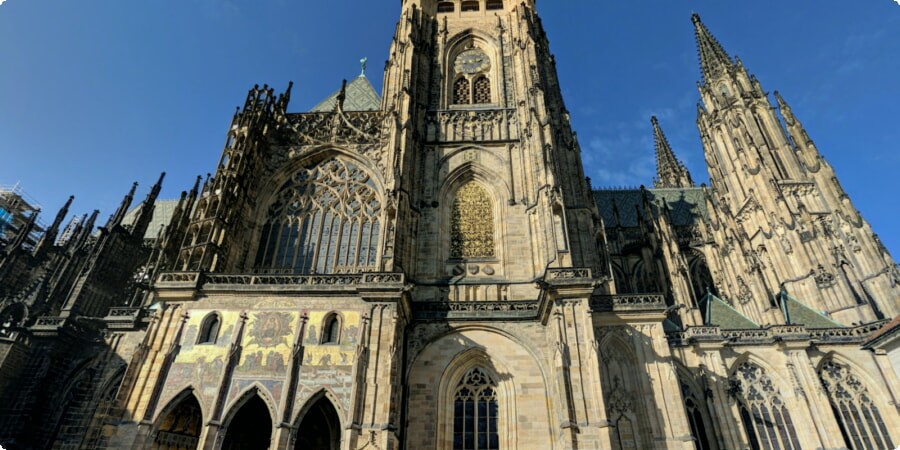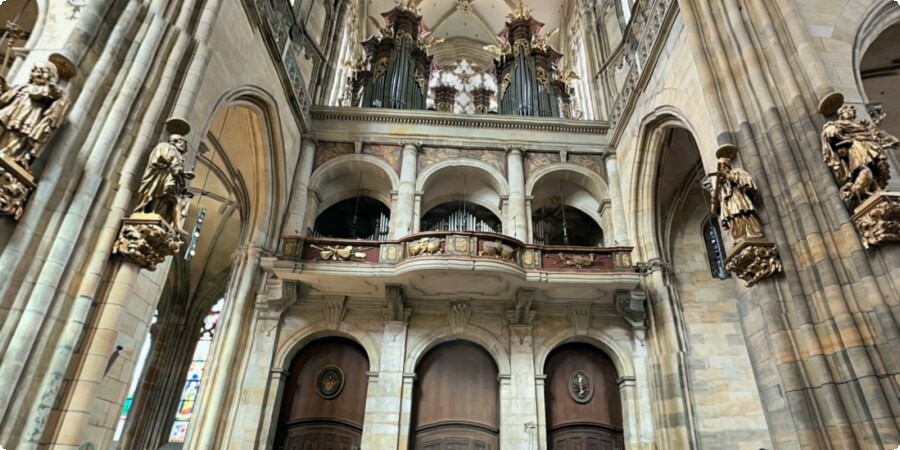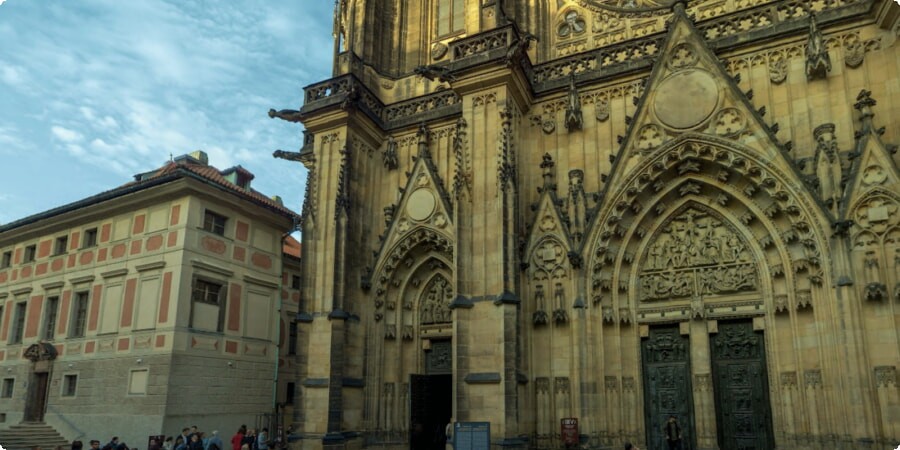St. Vitus Cathedral: Prague’s Majestic Gothic Masterpiece
St. Vitus Cathedral, a towering symbol of Prague’s rich history and architectural grandeur, dominates the skyline of Prague Castle. This Gothic masterpiece, a cornerstone of Czech national identity, serves as the principal church of the Czech state and a pivotal site for numerous historical events.
Location and Significance: Nestled within the sprawling Prague Castle complex, St. Vitus Cathedral is not only an architectural marvel but also a spiritual beacon. The cathedral’s impressive spires and intricate facade make it one of Prague’s most recognizable landmarks. It has witnessed centuries of Czech history, from royal coronations to state ceremonies.
Architectural and Cultural Importance: As a major religious and cultural landmark, the cathedral represents the zenith of Gothic architecture in the Czech Republic. It stands as a testament to the artistic and spiritual aspirations of its era, embodying both the artistic achievements and the historical significance of Prague.
For a closer look at St. Vitus Cathedral and to plan your visit, you can explore its location on Google Maps.
The History of St. Vitus Cathedral
The history of St. Vitus Cathedral is a tale of ambition, devotion, and architectural innovation. The cathedral’s construction began in the late 14th century, spearheaded by Emperor Charles IV, who envisioned a grand cathedral to house the relics of St. Vitus and serve as a prominent symbol of his reign.
Early Beginnings: The foundation stone of St. Vitus Cathedral was laid in 1344, and the initial design was created by architect Matthias of Arras. His Gothic design reflected the growing trend of verticality and intricate ornamentation typical of the period. The construction was a massive undertaking, involving several architects and craftsmen over more than six centuries.

Key Historical Milestones:
- Completion of the Nave: The cathedral’s nave, one of its most striking features, was completed in the late 15th century. This segment of the cathedral showcases the transition from Early to High Gothic style.
- Royal Significance: Throughout its history, the cathedral has been the site of numerous royal events, including the coronation of Czech kings and queens. It also holds the tombs of several important figures, including Charles IV and other members of the Czech royal family.
- Modern Era: The cathedral has undergone various renovations and restorations, particularly after periods of conflict and damage. In recent decades, efforts have been focused on preserving its Gothic splendor while accommodating modern visitors.
To delve deeper into the historical timeline of St. Vitus Cathedral, check out its Wikipedia page.
Architectural Marvels
St. Vitus Cathedral is renowned for its breathtaking Gothic architecture, which combines intricate design with profound symbolic meaning. The cathedral’s architecture exemplifies the grandeur of Gothic style, characterized by its vertical lines and elaborate details.
Key Architectural Features:
- Flying Buttresses: These external supports are essential for stabilizing the cathedral’s tall walls and allowing for large stained glass windows. The buttresses are a hallmark of Gothic architecture and contribute to the cathedral’s ethereal appearance.
- Rose Windows: The cathedral features several stunning rose windows, which are large, circular stained glass windows adorned with intricate patterns. These windows not only enhance the cathedral’s beauty but also serve to illustrate biblical stories and saints.
- Main Facade: The main entrance of the cathedral is an architectural marvel, adorned with sculptural details depicting scenes from the life of Christ. The facade’s pointed arches and detailed carvings exemplify the Gothic style’s emphasis on verticality and light.
Interior Splendor: Inside, the cathedral boasts an array of chapels, altars, and tombs, each contributing to its majestic atmosphere. Notable features include the Silver Chapel, renowned for its opulent decoration, and the St. Wenceslas Chapel, which houses the tomb of St. Wenceslas, the patron saint of Bohemia.
For a closer look at the architectural details of St. Vitus Cathedral, you can explore more about its design and features on Wikipedia.

The Cathedral’s Interior: A Closer Look
Stepping inside St. Vitus Cathedral reveals an awe-inspiring interior that reflects the grandeur of Gothic design. The cathedral’s vast, high-ceilinged nave, rich with intricate details and religious significance, offers a mesmerizing experience for visitors.
Main Altar: The centerpiece of the cathedral’s interior is its main altar, dedicated to St. Vitus. This splendid altar is adorned with elaborate carvings and features a striking reredos, or ornamental screen, that highlights scenes from the life of St. Vitus. The altar is a focal point for worship and a testament to the cathedral's religious importance.
St. Wenceslas Chapel: This chapel is one of the most revered parts of the cathedral. It houses the tomb of St. Wenceslas, the patron saint of Bohemia, and is renowned for its exquisite decoration. The chapel is lined with richly decorated walls and contains a golden reliquary that holds the saint’s remains. The vibrant stained glass windows here illuminate the chapel in a soft, ethereal light, adding to its sanctity.
The Silver Chapel: Another notable feature is the Silver Chapel, which is celebrated for its opulent decoration and elaborate silver altar. This chapel is dedicated to the Virgin Mary and features an array of precious metals and intricate designs, reflecting the artistic and material wealth of the period.
Chapels and Tombs: Throughout the cathedral, various chapels and tombs contribute to its rich interior tapestry. Each chapel has its own unique design and purpose, from memorials to various saints to family chapels dedicated to Czech nobility. The cathedral also houses the tombs of several significant historical figures, adding layers of historical depth to the visit.
For those planning to explore Prague and its surroundings, consider renting a car for greater flexibility. You can find convenient car rental options throughout the Czech Republic at Solrentacar.
The Role of St. Vitus Cathedral in Czech History
St. Vitus Cathedral is not just an architectural marvel; it has played a central role in Czech history and culture for centuries. Its significance extends beyond its physical presence, deeply intertwined with the nation’s historical and religious narrative.
Royal Coronations: The cathedral has been the site of numerous royal coronations, marking it as a key location in the Czech monarchy’s history. Notably, Charles IV, the Holy Roman Emperor, was crowned King of Bohemia here, and several other Czech kings and queens were also crowned within its walls. The grandeur of the cathedral provided a fitting backdrop for these momentous ceremonies.
State Ceremonies: Over the centuries, St. Vitus Cathedral has hosted various state ceremonies, including significant national events and celebrations. Its role in these ceremonies underscores its importance as a symbol of national unity and continuity.
Historical Events: The cathedral has witnessed several pivotal moments in Czech history. During the Hussite Wars, it suffered damage but was later restored, reflecting the resilience of both the building and the Czech people. The cathedral also played a role in the Czech National Revival, symbolizing the cultural and historical resurgence of the Czech nation.
For a deeper exploration of the cathedral’s historical role, visit its Wikipedia page.

The Stained Glass Windows: Art and Symbolism
One of the most captivating features of St. Vitus Cathedral is its collection of stained glass windows. These windows are not only artistic masterpieces but also rich in symbolism and historical significance.
Artistic Design: The stained glass windows of St. Vitus Cathedral are renowned for their vibrant colors and intricate designs. Created by various artists over the centuries, these windows depict scenes from biblical stories, saints, and historical events. Each window serves as a work of art, reflecting the medieval fascination with light and color as well as the spiritual messages conveyed through the imagery.
Symbolism: The windows are not merely decorative; they carry deep symbolic meaning. For instance, the windows often illustrate the life of Christ, the lives of saints, and key theological concepts. The use of light to convey spiritual themes is a hallmark of Gothic art, and the stained glass windows at St. Vitus Cathedral are prime examples of this technique.
Notable Windows: Among the most notable windows is the Rose Window on the west facade, which is a stunning example of Gothic stained glass. This large, circular window is adorned with intricate patterns and vivid colors, creating a mesmerizing effect as sunlight filters through.
Exploring the Cathedral’s Towers and Views
The towers of St. Vitus Cathedral offer visitors not only a deeper appreciation of its architectural splendor but also breathtaking panoramic views of Prague. Climbing these towers provides a unique perspective on the cathedral and the city beyond.
South Tower: The South Tower, standing at 96.5 meters, is the most prominent of the cathedral’s towers and offers the best vantage point for sweeping views of Prague. Visitors can climb the 287 steps to reach the top, where they are rewarded with a stunning view of the cityscape, including the Vltava River, Charles Bridge, and the surrounding areas.
North Tower: The North Tower, while less accessible, is notable for its historical significance. It houses the cathedral’s bells and features intricate Gothic architectural details. Although not open to the public for climbing, it contributes to the cathedral’s imposing silhouette and structural integrity.
Visitor Tips: When planning your visit to the towers, be prepared for a strenuous climb. The stairways are narrow and steep, but the effort is well worth it for the panoramic views. The best time to visit is early in the morning or late in the afternoon to avoid crowds and enjoy optimal lighting for photography.

Practical Information for Visitors
When visiting St. Vitus Cathedral, having the right information can enhance your experience and ensure a smooth visit. Here are some essential details to help you plan your trip.
Opening Hours: The cathedral is typically open daily, with hours that may vary depending on the season. It’s advisable to check the official website or local tourist information for current hours before your visit.
Admission Fees: There is an entrance fee to access the cathedral and its various sections. Tickets can be purchased on-site or in advance. Discounts may be available for students, seniors, and groups.
Guided Tours: For a more comprehensive experience, consider joining a guided tour. Tours provide in-depth knowledge about the cathedral’s history, architecture, and significant features. Audio guides are also available for those who prefer a self-guided experience.
Nearby Attractions: St. Vitus Cathedral is located within the Prague Castle complex, so visitors can explore other nearby attractions such as the Old Royal Palace, Golden Lane, and the Prague Castle Gardens. It’s worth allocating extra time to explore these adjacent sites.
The Future and Preservation of St. Vitus Cathedral
Preserving St. Vitus Cathedral’s historical and architectural integrity is a continuous effort involving extensive maintenance and restoration work. As one of Prague’s most important landmarks, ensuring its preservation is crucial for future generations.
Restoration Efforts: The cathedral has undergone several restoration projects over the years to address damage caused by natural wear, historical events, and environmental factors. Recent projects focus on preserving the intricate stonework, stained glass windows, and structural stability. These efforts are often funded by both public and private contributions.
Challenges: Maintaining a historic structure of such significance presents numerous challenges. Issues such as pollution, weathering, and the sheer scale of the cathedral require ongoing attention and specialized expertise. The preservation work aims to balance maintaining the cathedral’s historical authenticity while adapting to modern conservation standards.
Community Involvement: Local and international organizations, as well as dedicated volunteers, play a vital role in supporting the preservation of St. Vitus Cathedral. Public awareness and involvement are essential in ensuring the cathedral’s continued survival and appreciation.